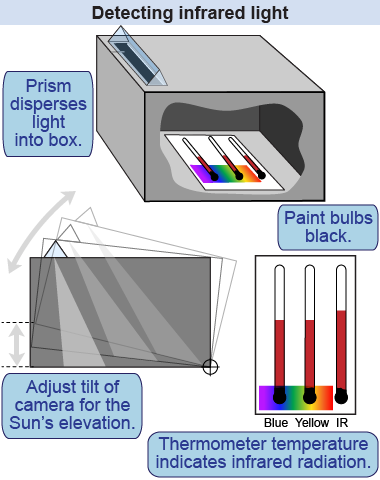| | Essential questions | | How can we detect infrared light if it is invisible? | |
|
William Herschel discovered infrared light in 1800. Herschel conducted an experiment in which he passed white light through a prism and measured the temperature differences between the colors of the visible spectrum. To gauge the ambient temperature near his experiment, Herschel placed an additional thermometer beyond the red light. To his surprise, this thermometer measured a temperature greater than that of any of the others. Herschel speculated that invisible light was responsible; he had discovered infrared radiation. In this investigation, you will conduct Herschel’s experiment by measuring the temperatures of blue, yellow, and infrared light. 
|
Part 1: Detecting infrared light dispersed by a prism

- Attach a triangular prism to a cardboard box to disperse sunlight onto the bottom of the box.
- Cover the bulbs of three alcohol thermometers with black paint or black permanent marker.
- Experiment with the slit width and tilt of the prism and box to obtain a sharp, bright spectrum.
- Attach two thermometers to the bottom surface of the box so that the bulbs are in the blue and yellow light. Attach the third several millimeters beyond the red part of the spectrum.
- Let the system come to equilibrium for 5–10 min, then measure the temperature differences between the thermometers.
- Switch the places of the thermometers twice, each time letting the temperatures equilibrate and measuring the temperature differences.
- Record each set of results and average them.

- What is the purpose of the black paint or permanent marker?
- Do you need to cover the box while the thermometers are heating?
- Why should you switch the positions of the thermometers for each set of measurements?
- Which thermometer gives the highest reading each time?
- How well do you think this method would work for detecting ultraviolet light?
- Predict how the experimental results might differ if you used a different light source.
- Explain whether the prism works better when illuminated by a diffuse or a narrow beam.
- Analyze your observations: Do they require infrared light to explain the solar spectrum?
- Meet with another lab group and present to each other your designs and performance. Critique each other’s observational data. Evaluate whether or not the other group’s observations require infrared light to be part of the solar spectrum.
- As a result of this discussion, are there ways that you could revise your experiment to produce a more definitive result? Implement these changes and collect a new set of observations of the Sun.

| |
| |
|

